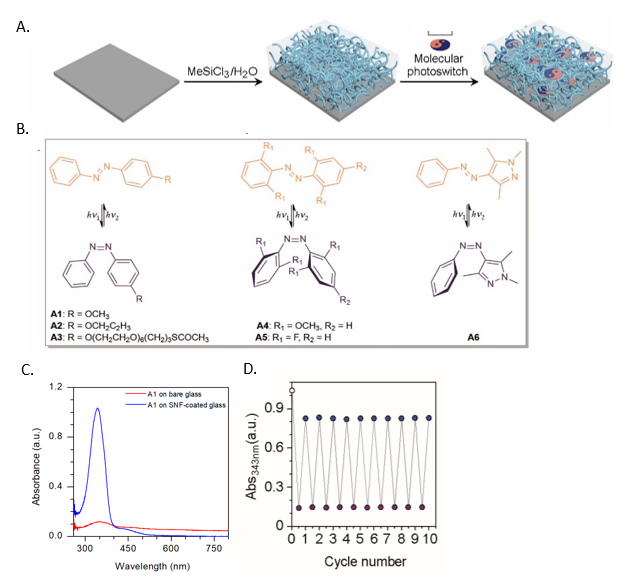Molecular photoswitches are light-responsive molecules with potential applications in a broad range of systems with on-demand functionalities. While molecular photoswitches have been extensively studied in solution, their immobilization to dry, planar surfaces generally renders them photochemically unresponsive. This invention presents a technique for modification of dry surfaces to render them amenable to molecular switch integration. Dry surfaces are coated with a transparent, nanoporous fiber network onto which molecular photoswitches are dispersed. Tested photoswitches demonstrated high-density loading, retained their activity, and proved stable over time. The proposed technique promises to expand the applicability of photoswitches in a broad array of functional materials including flexible substrates, as well as to enable dry surface integration of other molecular switches operating on signals other than light.
Molecular photoswitches are photoactive molecules that can be shifted to a new state by irradiation with light of a specific wavelength, and then reverted back to its original state by irradiation at a different wavelength or via thermal relaxation in the dark. While their behavior and potential application have been extensively characterized in solution, the efficiency of switching in surface-immobilized molecular photoswitches is hindered by surface coverage limits, photoreaction quenching arising from electronic coupling between the solid surface and the switch chromophore, as well as conformational freedom constraints following immobilization. These pose critical barriers to development of light-responsive materials and to full realization of their potential incorporation into functional devices and molecular machines.
A novel solution for molecular switch integration on solid surfaces developed by a group of researchers from the Weizmann Institute enables a new set of molecular switch functionalities. In electronics, switches are responsible for the processing and storage of information, but, increasingly, switches are required to get much smaller, entering the domain of ‘molecular switches’ which can be exploited in molecular recognition and electronics, biological applications, medical therapeutics, materials, and supramolecular chemistry, to name only a few areas.
This invention preserves photoswitchability by derivatizing a broad range of surfaces with a thin (1 mm) nanoporous polysiloxane (silicone) network layer. The silicone network is both transparent, ensuring maximal light transmission, and highly hydrophobic, enabling its interaction with a wide range of molecular switches. Moreover, its large surface area allows for high-density adsorption, up to two orders of magnitude higher than untreated surfaces. Model glass substrates roughened with polysiloxane nanofilament networks and doped with molecular switches displayed excellent photoswitchable properties, which were maintained for a similar number of cycles as in liquid medium. Nanofilament fibers were found to be stable for over one year with no functionality deterioration at room temperature, and promising heat stability results were obtained for up to 800 0C.

A( Schematic illustration of the preparation of the porous networks on flat, solid substrates and subsequent immobilization of photoswitchable molecules via physical adsorption.
B) Examples of the reversible conformation change in several photoswitches.
C) UV/Vis absorption spectrum of a molecular photoswitch A1 deposited on a polysiloxane nanofilament network (SNF)-coated glass slide (blue) versus on bare glass slide (red).
D) Ten cycles of reversible photoswitching of a surface-confined molecular photoswitch A1 (each cycle consisted of 3 min of UV exposure, followed by 2 min of blue light).
- Expanded application of molecular switches
- Transparent filament networks preserve photoswitching efficiency
- High-density surface functionalization
- Filaments stable under a range of chemical, photochemical and heat conditions
- Facile and cost-effective network production and integration
The surface modifying technique has been demonstrated to preserve the photoswitching capacities of approximately ten molecular photoswitches on a broad range of solid substrates including flexible surfaces and demonstrated long-term stability of more than a year at room temperature. Future work will seek to expand the range of molecular switches compatible with the silicone nanofiber-modified surfaces.
Market opportunities include:
Functional optical devices
Internet of things (IoT) technologies, e.g., software, services, connectivity and devices, a global market reaching $130 bn in 2018 and projected to grow to $318 bn by 2023.
- Electronics – data storage and logic components
- Construction – smart materials including smart windows
- Smart wearables, which 2018 estimates projected a doubling by 2022, to reach a $27 bn market, with 233 million unit sales.
- Photosensors, which has been forecasted to grow at a stable compound annual growth rate of 8% between 2018 and 2026.
- Biomedical arena - molecular recognition, therapeutics, diagnostics, photopharmacology
- Solid-state fluorophore platform

